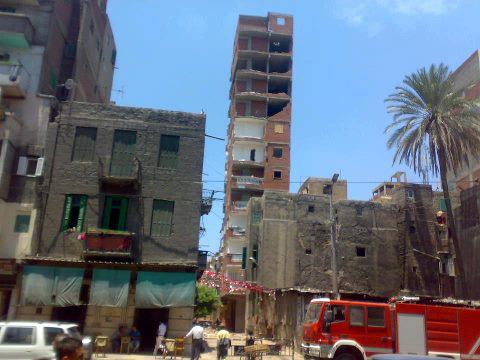
That just three people — a mother and her daughters — died when a building collapsed in Alexandria on Monday places the incident amongst the least deadly of the increasingly common collapses in the city.
One collapse in the Gomrok district took 22 lives down with it to the dust less than a fortnight ago. Yet, for all the tragedy, the collapse and the response followed a familiar pattern. The building owner illegally adds extra floors and the building falls, leading to deaths and injuries. Outrage follows and an arrest is made as the authorities promise to crack down on illegal developments, but the cycle is repeated elsewhere.
According to residents of Gomrok, in this case the owner ignored previous safety warnings, shunned civil engineers and architects, and bribed his way into adding additional floors.
‘Everyone wants to make money’
According to Islam Assem, the secretary general of the Alexandria Tourist Guides Syndicate and a specialist in Alexandria's urban politics, the suspect arrested, Mohamed Ibrahim, was probably not even the owner, but rather a kahool. The term refers to a 'fall-guy' who agrees to take on the formal legal responsibilities of ownership and therefore takes the blame in the event of a disaster.
Prospective builders will approach an impoverished person and offer a sum of around LE100,000 in return for a signature on all official papers. When the authorities come for the owner, they arrest the kahool, and the real owner walks away.
A loose network of land-lords, kahools, unscrupulous contractors, corrupt district engineers, crooked or apathetic police officers, and hired thugs make up what can be described as “Alexandria’s real estate mafia,” according to Mohamed Aboelkheir, an architect and lecturer at the Arab Academy for Science and Technology.
Aboelkheir says that in the power vacuum that followed the fall of Hosni Mubarak last year, this real estate mafia went into overdrive. He says they destroyed heritage sites, added new floors to structurally unsound buildings, and built apartment complexes to dangerous heights, often with a tacky Greco-Roman finish. It is difficult to find a street in Alexandria that is not marked by such developments. Speaking to Egypt Independent, Assem popped his head out of the window of his home and counted half a dozen buildings being extended or built.
As the presidential elections neared, construction accelerated as workers demolished and built into the dead of the night in an effort to complete buildings before the incoming president assumed authority.
A few months ago, Egypt Independent challenged a developer in the suburb of Camp Shezar following the destruction of an old villa that was to be replaced with another high-rise apartment complex. “It’s a revolution, everyone wants to make money,” he replied.
According to Aboelkheir, the construction mafia have a back-up plan if they fail to successfully bribe the authorities. “If the authorities attempt to demolish the illegal extra floors, or the whole building, the owners will pre-empt this by selling the highest floors first,” he says. The strategy makes demolition legally problematic for the authorities.
Furthermore, according to Assem, the penalty for unapproved construction can start at LE500,000, which the owner can offset with one of the apartments sold.
In March, Egypt Independent interviewed a building owner in the middle class suburb of Cleopatra Hamamat who narrated a recent phone conversation between himself and a developer. The developer offered to add “up to 12” floors to his five-story building, and make them both “a lot of money.”
“That is dangerous,” the owner responded. “The space and structure will not tolerate such a heavy load on it, nor can you obtain a licence.” The developer replied, he said, that they would not need to worry about the licence. When he asked what would happen to the current tenants, the developer had a ready answer: “We will give them a paper to say they will get an apartment, but we won’t give them anything; the paper will not be legally binding."
In this case, the building owner refused the deal. But, he says, many others do not.
Responsibility and solutions
Egypt Independent attended a roundtable meeting in April that included the city’s governor Osama al-Fouly, academics, experts, and activists, to discuss the wildcat construction problem in Alexandria. Fouly claimed that he has been signing, daily, a staggering 150-180 orders halting illegal construction. He says he has sent a document to Cairo listing 12,300 violations, but complained about lack of cooperation from the armed forces and Interior Ministry.
According to the State Information Service, President Mohamed Morsy has assigned a committee to investigate the collapse of the Gomrok building.
Assem says that the real estate mafia is more than just an Alexandrian problem. “It always comes down to decision-makers looking for quick and temporary solutions, never planning ahead and considering the problematic future scenario, let alone how to shift course onto sustainable development,” he says.
Shifting foundations
Mohamed Adel Dessouky, architect and member of the Alexandrian Architectural Heritage Conservation Committee, documents Alexandria's real-estate crisis on his Walls of Alex blog. He told Egypt Independent that the recent collapse in Gomrok was because “it lacked any sort of structural foundations, built without any engineers or consultants, just an ignorant contractor … We reported hundreds of cases to the army in 2011, but they did not take any action. They are the ones to blame.”
“These people [owners and contractors] have no idea of the soil properties that may cause a building to collapse if the foundations were not designed properly, if they were even designed at all,” says Aboelkheir.
The rushed building is itself dangerous, says Egyptian-American engineer Nabil Ahmed. “It takes at least ten days for the foundation and a floor’s cement to dry and solidify, yet seventeen floors are built in three months with materials that are not even original,” he says. “We are talking about a high risk of collapse.”
In the Gomrok case, the building fell onto three other homes and destroyed the local bakery that provides for the district. This also left butane gas pipes buried beneath the rubble that could explode.
It used to be the case that unauthorised construction was largely limited to impoverished areas, yet in the past year and half, it has spread throughout Alexandria.
“What if an earthquake struck Alexandria?” asks Dessouky.
During the 1992 Cairo earthquake over 350 poorly constructed buildings collapsed, mainly in informal settlements. However, Aboelkheir, Dessouky, and Ahmed are unanimous that an earthquake in Alexandria today would cause collapses crossing the city's socio-economic fault-lines. “God save us,” Dessouky mutters.
Even putting aside the risk of collapse, in design terms, the buildings are a disaster, according to architects and engineers. Aboelkheir and Ahmed point to the lack of proper ventilation, sunlight, garage space, and the added pressure on a district’s utilities, transport capacity, parking, and already suffocated public space.
Aboelkheir calls them “coffin apartments.”




